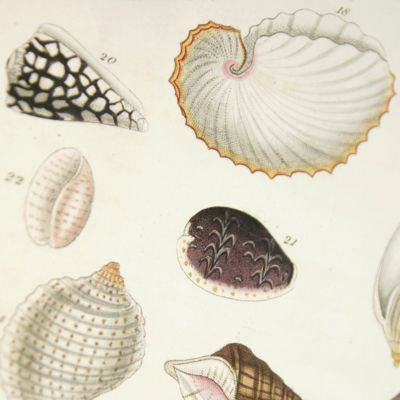Graves, G.
The naturalist's pocket-book, or tourist's companion, being a brief introduction to the different branches of natural history, with approved methods for collecting and preserving the various productions of nature.
London, Longman, Hurst, Rees, Orme, and Brown, 1818. 8vo (22.5 x 14.0 cm). [iv], viii, [ii], 335 pp. Eight engraved plates of which five zoological plates in original hand-colouring (as intended). Original pink boards with original printed label on the spine.
Written by the printer, publisher and naturalist George Graves (1784-1839), this is a little-known review of the Linnaean systematics, larded with advice about collecting and preserving natural history objects. "Written in the tradition of Francis Bacon, it expressed the belief that natural history was about the exploration of nature's bounty for the benefits it could bring to humans: It is not by the mere accumulating [of] a large variety of curious species that the science is advanced, but it is by acquiring a knowledge of the habits and propensities, the contrasts, the similarities, the uses or injuries they offer to mankind, that gives life and spirit to the science; and in fact is the true and only real use of the study. The book included sample pages showing the layout which Graves used in his own field notebook, with columns for recording important facts about these points as each item was observed. This encouraged collectors to keep a field notebook recording the information needed for accurate labelling and a formal description of the object. Excerpts from these field notebooks were often included in published descriptions" (Wikipedia). This work inspired Charles Darwin: "In August 1825 the young Charles Darwin bought a copy of A Naturalist's Companion by Graves in anticipation of seaside walks with his older brother Erasmus Alvey Darwin once he went up to Edinburgh in October of that year to begin his undergraduate studies at the University of Edinburgh. The brothers went for regular Sunday walks on the shores of the Firth of Forth and Darwin kept a diary recording their finds, which included a sea mouse and a cuttlefish. In his second year Charles became active in student societies for naturalists, and joined with others interested in collecting on the shores of the Firth" (Wikipedia). There appear to be two editions of this work. Initially, it was sold by the author, who was also one of the printers. This was shortly followed by this Longman et al. edition (a new title edition, as the main text was from the same, unaltered). The British Museum library catalogue errs in suggesting that all plates are coloured. Only the two ornithological plates, the entomological plate and the two malacological plates, are hand-coloured. The equipment plates are always plain. Uncut. Bound in front: a four-page catalogue of Longman et al. titles (dated April 1818), and a two-page catalogue of other works by Graves. A handwritten dedication, by E. N. Muir (?), to "the museum of his nephew at Beeston", dated 7 May 1839. An old pencil drawing of a building (unsigned and not connected to this work) loosely inserted. Some wear to the board edges and spine ends, a few leaves a trifle spotted; otherwise very good. Cat. BM(NH) p. 709. Not in Nissen.


![image for [Alert voyage] Report on the zoological collections made in the Indo-Pacific Ocean during the voyage of the HMS Alert 1881-1882.](https://schierenberg.nl/media/cache/product_thumb/75370/75370.jpg)


